CCSD Curriculum Elements
Cobb County World Language Program courses are designed to assist the students' development of language and intercultural skills. Each course has set learning targets based on ACTFL's language proficiency standards and NCSSFL-ACTFL Can Do Statements. ACTFL standards goal areas are: Communication, Cultures, Connections, Comparisons, and Communities.
Communication
This is the main area of the standards and in which we based a great part of our course program. There are three modes within the communication standards, Interpersonal, Presentational, and Interpretive. Use the links below to learn more about the language domains and sublevels for each mode.
| MODES | |||||
| LEVELS | |||||
| Novice | 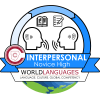 |
 |
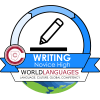 |
 |
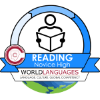 |
| Intermediate |  |
 |
 |
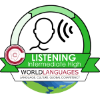 |
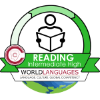 |
| Advanced | 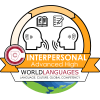 |
 |
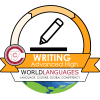 |
 |
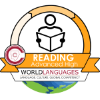 |
Culture
The study of culture and language is strongly interconnected. Students use the language to investigate and interact properly with the practices, perspectives, and products of the various cultures.
| LEVELS | |||
| Novice |  |
 |
 |
| Intermediate |  |
 |
 |
| Advanced |  |
 |
 |
For more information and resources about language proficiency go to the American Council for Teachers of Foreign Languages (ACTFL) at: https://www.actfl.org/
At the Intermediate level, readers can understand information conveyed in simple, predictable, loosely connected texts. Readers rely heavily on contextual clues. They can most easily understand information if the format of the text is familiar, such as in a weather report or a social announcement.
Intermediate-level readers are able to understand texts that convey basic information such as that found in announcements, notices, and online bulletin boards and forums. These texts are not complex and have a predictable pattern of presentation. The discourse is minimally connected and primarily organized in individual sentences and strings of sentences containing predominantly high frequency vocabulary.
Intermediate-level readers are most accurate when getting meaning from simple, straightforward texts. They are able to understand messages found in highly familiar, everyday contexts. At this level, readers may not fully understand texts that are detailed or those texts in which knowledge of language structures is essential in order to understand sequencing, time frame, and chronology.
 Intermediate High
Intermediate High
At the Intermediate High sublevel, readers are able to understand fully and with ease short, non-complex texts that convey basic information and deal with personal and social topics to which the reader brings personal interest or knowledge. These readers are also able to understand some connected texts featuring description and narration although there will be occasional gaps in understanding due to a limited knowledge of the vocabulary, structures, and writing conventions of the language.
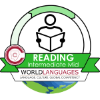 Intermediate Mid
Intermediate Mid
At the Intermediate Mid sublevel, readers are able to understand short, non-complex texts that convey basic information and deal with basic personal and social topics to which the reader brings personal interest or knowledge, although some misunderstandings may occur. Readers at this level may get some meaning from short connected texts featuring description and narration, dealing with familiar topics.
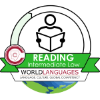 Intermediate Low
Intermediate Low
At the Intermediate Low sublevel, readers are able to understand some information from the simplest connected texts dealing with a limited number of personal and social needs, although there may be frequent misunderstandings. Readers at this level will be challenged to derive meaning from connected texts of any length.
For additional information go to
ACTFL PROFICIENCY GUIDELINES 2012
- Details
- Category: Language Proficiency
- Hits: 9319
At the Novice level, readers can understand key words and cognates, as well as formulaic phrases that are highly contextualized. Novice-level readers are able to get a limited amount of information from highly predictable texts in which the topic or context is very familiar, such as a hotel bill, a credit card receipt, or a weather map. Readers at the Novice level may rely heavily on their own background knowledge and extralinguistic support (such as the imagery on the weather map or the format of a credit card bill) to derive meaning. Readers at the Novice level are best able to understand a text when they are able to anticipate the information in the text. At the Novice level, recognition of key words, cognates, and formulaic phrases makes comprehension possible
 Novice High
Novice High
At the Novice High sublevel, readers can understand, fully and with relative ease, key words and cognates, as well as formulaic phrases across a range of highly contextualized texts. Where vocabulary has been learned, they can understand predictable language and messages such as those found on train schedules, roadmaps, and street signs. Readers at the Novice High sublevel are typically able to derive meaning from short, non-complex texts that convey basic information for which there is contextual or extralinguistic support.
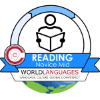 Novice Mid
Novice Mid
At the Novice Mid sublevel, readers are able to recognize the letters or symbols of an alphabetic or syllabic writing system or a limited number of characters in a character-based language. They can identify a number of highly contextualized words and phrases including cognates and borrowed words but rarely understand material that exceeds a single phrase. Rereading is often required.
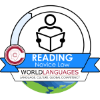 Novice Low
Novice Low
At the Novice Low sublevel, readers are able to recognize a limited number of letters, symbols or characters. They are occasionally able to identify high-frequency words and/or phrases when strongly supported by context.
For additional information go to
ACTFL PROFICIENCY GUIDELINES 2012
- Details
- Category: Language Proficiency
- Hits: 8398
Speakers at the Advanced level engage in conversation in a clearly participatory manner in order to communicate information on autobiographical topics, as well as topics of community, national, or international interest. The topics are handled concretely by means of narration and description in the major times frames of past, present, and future. These speakers can also deal with a social situation with an unexpected complication. The language of Advanced-level speakers is abundant, the oral paragraph being the measure of Advanced-level length and discourse. Advanced-level speakers have sufficient control of basic structures and generic vocabulary to be understood by native speakers of the language, including those unaccustomed to non-native speech.
 Advanced High
Advanced High
Speakers at the Advanced High sublevel perform all Advanced-level tasks with linguistic ease, confidence, and competence. They are consistently able to explain in detail and narrate fully and accurately in all time frames. In addition, Advanced High speakers handle the tasks pertaining to the Superior level but cannot sustain performance at that level across a variety of topics. They may provide a structured argument to support their opinions, and they may construct hypotheses, but patterns of error appear. They can discuss some topics abstractly, especially those relating to their particular interests and special fields of expertise, but in general, they are more comfortable discussing a variety of topics concretely.
Advanced High speakers may demonstrate a well-developed ability to compensate for an imperfect grasp of some forms or for limitations in vocabulary by the confident use of communicative strategies, such as paraphrasing, circumlocution, and illustration. They use precise vocabulary and intonation to express meaning and often show great fluency and ease of speech. However, when called on to perform the complex tasks associated with the Superior level over a variety of topics, their language will at times break down or prove inadequate, or they may avoid the task altogether, for example, by resorting to simplification through the use of description or narration in place of argument or hypothesis.
 Advanced Mid
Advanced Mid
Speakers at the Advanced Mid sublevel are able to handle with ease and confidence a large number of communicative tasks. They participate actively in most informal and some formal exchanges on a variety of concrete topics relating to work, school, home, and leisure activities, as well as topics relating to events of current, public, and personal interest or individual relevance.
Advanced Mid speakers demonstrate the ability to narrate and describe in the major time frames of past, present, and future by providing a full account, with good control of aspect. Narration and description tend to be combined and interwoven to relate relevant and supporting facts in connected, paragraph-length discourse.
Advanced Mid speakers can handle successfully and with relative ease the linguistic challenges presented by a complication or unexpected turn of events that occurs within the context of a routine situation or communicative task with which they are otherwise familiar. Communicative strategies such as circumlocution or rephrasing are often employed for this purpose. The speech of Advanced Mid speakers performing Advanced-level tasks is marked by substantial flow. Their vocabulary is fairly extensive although primarily generic in nature, except in the case of a particular area of specialization or interest. Their discourse may still reflect the oral paragraph structure of their own language rather than that of the target language.
Advanced Mid speakers contribute to conversations on a variety of familiar topics, dealt with concretely, with much accuracy, clarity and precision, and they convey their intended message without misrepresentation or confusion. They are readily understood by native speakers unaccustomed to dealing with non-natives. When called on to perform functions or handle topics associated with the Superior level, the quality and/or quantity of their speech will generally decline.
 Advanced Low
Advanced Low
Speakers at the Advanced Low sublevel are able to handle a variety of communicative tasks. They are able to participate in most informal and some formal conversations on topics related to school, home, and leisure activities. They can also speak about some topics related to employment, current events, and matters of public and community interest.
Advanced Low speakers demonstrate the ability to narrate and describe in the major time frames of past, present, and future in paragraph-length discourse with some control of aspect. In these narrations and descriptions, Advanced Low speakers combine and link sentences into connected discourse of paragraph length, although these narrations and descriptions tend to be handled separately rather than interwoven. They can handle appropriately the essential linguistic challenges presented by a complication or an unexpected turn of events.
Responses produced by Advanced Low speakers are typically not longer than a single paragraph. The speaker’s dominant language may be evident in the use of false cognates, literal translations, or the oral paragraph structure of that language. At times their discourse may be minimal for the level, marked by an irregular flow, and containing noticeable self-correction. More generally, the performance of Advanced Low speakers tends to be uneven.
Advanced Low speech is typically marked by a certain grammatical roughness (e.g., inconsistent control of verb endings), but the overall performance of the Advanced-level tasks is sustained, albeit minimally. The vocabulary of Advanced Low speakers often lacks specificity. Nevertheless, Advanced Low speakers are able to use communicative strategies such as rephrasing and circumlocution.
Advanced Low speakers contribute to the conversation with sufficient accuracy, clarity, and precision to convey their intended message without misrepresentation or confusion. Their speech can be understood by native speakers unaccustomed to dealing with non-natives, even though this may require some repetition or restatement. When attempting to perform functions or handle topics associated with the Superior level, the linguistic quality and quantity of their speech will deteriorate significantly.
For additional information go to
ACTFL PROFICIENCY GUIDELINES 2012
- Details
- Category: Language Proficiency
- Hits: 8735
Speakers at the Intermediate level are distinguished primarily by their ability to create with the language when talking about familiar topics related to their daily life. They are able to recombine learned material in order to express personal meaning. Intermediate level speakers can ask simple questions and can handle a straightforward survival situation. They produce sentence-level language, ranging from discrete sentences to strings of sentences, typically in present time. Intermediate-level speakers are understood by interlocutors who are accustomed to dealing with non-native learners of the language.
 Intermediate High
Intermediate High
Intermediate High speakers are able to converse with ease and confidence when dealing with the routine tasks and social situations of the Intermediate level. They are able to handle successfully uncomplicated tasks and social situations requiring an exchange of basic information related to their work, school, recreation, particular interests, and areas of competence.
Intermediate High speakers can handle a substantial number of tasks associated with the Advanced level, but they are unable to sustain performance of all of these tasks all of the time. Intermediate High speakers can narrate and describe in all major time frames using connected discourse of paragraph length, but not all the time. Typically, when Intermediate High speakers attempt to perform Advanced-level tasks, their speech exhibits one or more features of breakdown, such as the failure to carry out fully the narration or description in the appropriate major time frame, an inability to maintain paragraph-length discourse, or a reduction in breadth and appropriateness of vocabulary.
Intermediate High speakers can generally be understood by native speakers unaccustomed to dealing with non-natives, although interference from another language may be evident (e.g., use of code-switching, false cognates, literal translations), and a pattern of gaps in communication may occur.
 Intermediate Mid
Intermediate Mid
Speakers at the Intermediate Mid sublevel are able to handle successfully a variety of uncomplicated communicative tasks in straightforward social situations. Conversation is generally limited to those predictable and concrete exchanges necessary for survival in the target culture. These include personal information related to self, family, home, daily activities, interests and personal preferences, as well as physical and social needs, such as food, shopping, travel, and lodging.
Intermediate Mid speakers tend to function reactively, for example, by responding to direct questions or requests for information. However, they are capable of asking a variety of questions when necessary to obtain simple information to satisfy basic needs, such as directions, prices, and services. When called on to perform functions or handle topics at the Advanced level, they provide some information but have difficulty linking ideas, manipulating time and aspect, and using communicative strategies, such as circumlocution.
Intermediate Mid speakers are able to express personal meaning by creating with the language, in part by combining and recombining known elements and conversational input to produce responses typically consisting of sentences and strings of sentences. Their speech may contain pauses, reformulations, and self-corrections as they search for adequate vocabulary and appropriate language forms to express themselves. In spite of the limitations in their vocabulary and/or pronunciation and/or grammar and/or syntax, Intermediate Mid speakers are generally understood by sympathetic interlocutors accustomed to dealing with non-natives.
Overall, Intermediate Mid speakers are at ease when performing Intermediate-level tasks and do so with significant quantity and quality of Intermediate-level language.
 Intermediate Low
Intermediate Low
Speakers at the Intermediate Low sublevel are able to handle successfully a limited number of uncomplicated communicative tasks by creating with the language in straightforward social situations. Conversation is restricted to some of the concrete exchanges and predictable topics necessary for survival in the target-language culture. These topics relate to basic personal information; for example, self and family, some daily activities and personal preferences, and some immediate needs, such as ordering food and making simple purchases. At the Intermediate Low sublevel, speakers are primarily reactive and struggle to answer direct questions or requests for information. They are also able to ask a few appropriate questions. Intermediate Low speakers manage to sustain the functions of the Intermediate level, although just barely.
Intermediate Low speakers express personal meaning by combining and recombining what they know and what they hear from their interlocutors into short statements and discrete sentences. Their responses are often filled with hesitancy and inaccuracies as they search for appropriate linguistic forms and vocabulary while attempting to give form to the message. Their speech is characterized by frequent pauses, ineffective reformulations and self-corrections. Their pronunciation, vocabulary, and syntax are strongly influenced by their first language. In spite of frequent misunderstandings that may require repetition or rephrasing, Intermediate Low speakers can generally be understood by sympathetic interlocutors, particularly by those accustomed to dealing with non-natives.
For additional information go to
ACTFL PROFICIENCY GUIDELINES 2012
- Details
- Category: Language Proficiency
- Hits: 9932
Novice-level speakers can communicate short messages on highly predictable, everyday topics that affect them directly. They do so primarily through the use of isolated words and phrases that have been encountered, memorized, and recalled. Novice-level speakers may be difficult to understand even by the most sympathetic interlocutors accustomed to non-native speech.
 Novice High
Novice High
Speakers at the Novice High sublevel are able to handle a variety of tasks pertaining to the Intermediate level, but are unable to sustain performance at that level. They are able to manage successfully a number of uncomplicated communicative tasks in straightforward social situations. Conversation is restricted to a few of the predictable topics necessary for survival in the target language culture, such as basic personal information, basic objects, and a limited number of activities, preferences, and immediate needs. Novice High speakers respond to simple, direct questions or requests for information. They are also able to ask a few formulaic questions.
Novice High speakers are able to express personal meaning by relying heavily on learned phrases or recombinations of these and what they hear from their interlocutor. Their language consists primarily of short and sometimes incomplete sentences in the present, and may be hesitant or inaccurate. On the other hand, since their language often consists of expansions of learned material and stock phrases, they may sometimes sound surprisingly fluent and accurate. Pronunciation, vocabulary, and syntax may be strongly influenced by the first language. Frequent misunderstandings may arise but, with repetition or rephrasing, Novice High speakers can generally be understood by sympathetic interlocutors used to nonnatives. When called on to handle a variety of topics and perform functions pertaining to the Intermediate level, a Novice High speaker can sometimes respond in intelligible sentences, but will not be able to sustain sentence-level discourse.
 Novice Mid
Novice Mid
Speakers at the Novice Mid sublevel communicate minimally by using a number of isolated words and memorized phrases limited by the particular context in which the language has been learned. When responding to direct questions, they may say only two or three words at a time or give an occasional stock answer. They pause frequently as they search for simple vocabulary or attempt to recycle their own and their interlocutor’s words. Novice Mid speakers may be understood with difficulty even by sympathetic interlocutors accustomed to dealing with non-natives. When called on to handle topics and perform functions associated with the Intermediate level, they frequently resort to repetition, words from their native language, or silence.
 Novice Low
Novice Low
Speakers at the Novice Low sublevel have no real functional ability and, because of their pronunciation, may be unintelligible. Given adequate time and familiar cues, they may be able to exchange greetings, give their identity, and name a number of familiar objects from their immediate environment. They are unable to perform functions or handle topics pertaining to the Intermediate level, and cannot therefore participate in a true conversational exchange.
For additional information go to
ACTFL PROFICIENCY GUIDELINES 2012
- Details
- Category: Language Proficiency
- Hits: 9965
Writers at the Advanced level are characterized by the ability to write routine informal and some formal correspondence, as well as narratives, descriptions, and summaries of a factual nature. They can narrate and describe in the major time frames of past, present, and future, using paraphrasing and elaboration to provide clarity. Advanced-level writers produce connected discourse of paragraph length and structure. At this level, writers show good control of the most frequently used structures and generic vocabulary, allowing them to be understood by those unaccustomed to the writing of non-natives.
 Advanced High
Advanced High
Writers at the Advanced High sublevel are able to write about a variety of topics with significant precision and detail. They can handle informal and formal correspondence according to appropriate conventions. They can write summaries and reports of a factual nature. They can also write extensively about topics relating to particular interests and special areas of competence, although their writing tends to emphasize the concrete aspects of such topics. Advanced High writers can narrate and describe in the major time frames, with solid control of aspect. In addition, they are able to demonstrate the ability to handle writing tasks associated with the Superior level, such as developing arguments and constructing hypotheses, but are not able to do this all of the time; they cannot produce Superior-level writing consistently across a variety of topics treated abstractly or generally. They have good control of a range of grammatical structures and a fairly wide general vocabulary. When writing at the Advanced level, they often show remarkable ease of expression, but under the demands of Superior-level writing tasks, patterns of error appear. The linguistic limitations of Advanced High writing may occasionally distract the native reader from the message.
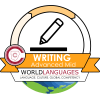 Advanced Mid
Advanced Mid
Writers at the Advanced Mid sublevel are able to meet a range of work and/or academic writing needs. They demonstrate the ability to narrate and describe with detail in all major time frames with good control of aspect. They are able to write straightforward summaries on topics of general interest. Their writing exhibits a variety of cohesive devices in texts up to several paragraphs in length. There is good control of the most frequently used target-language syntactic structures and a range of general vocabulary. Most often, thoughts are expressed clearly and supported by some elaboration. This writing incorporates organizational features both of the target language and the writer’s first language and may at times resemble oral discourse. Writing at the Advanced Mid sublevel is understood readily by natives not used to the writing of nonnatives. When called on to perform functions or to treat issues at the Superior level, Advanced Mid writers will manifest a decline in the quality and/or quantity of their writing.
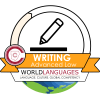 Advanced Low
Advanced Low
Writers at the Advanced Low sublevel are able to meet basic work and/or academic writing needs. They demonstrate the ability to narrate and describe in major time frames with some control of aspect. They are able to compose simple summaries on familiar topics. Advanced Low writers are able to combine and link sentences into texts of paragraph length and structure. Their writing, while adequate to satisfy the criteria of the Advanced level, may not be substantive. Writers at the Advanced Low sublevel demonstrate the ability to incorporate a limited number of cohesive devices, and may resort to some redundancy and awkward repetition. They rely on patterns of oral discourse and the writing style of their first language. These writers demonstrate minimal control of common structures and vocabulary associated with the Advanced level. Their writing is understood by natives not accustomed to the writing of non-natives, although some additional effort may be required in the reading of the text. When attempting to perform functions at the Superior level, their writing will deteriorate significantly.
For additional information go to
ACTFL PROFICIENCY GUIDELINES 2012
- Details
- Category: Language Proficiency
- Hits: 8357
Writers at the Intermediate level are characterized by the ability to meet practical writing needs, such as simple messages and letters, requests for information, and notes. In addition, they can ask and respond to simple questions in writing. These writers can create with the language and communicate simple facts and ideas in a series of loosely connected sentences on topics of personal interest and social needs. They write primarily in present time. At this level, writers use basic vocabulary and structures to express meaning that is comprehensible to those accustomed to the writing of non-natives.
 Intermediate High
Intermediate High
Writers at the Intermediate High sublevel are able to meet all practical writing needs of the Intermediate level. Additionally, they can write compositions and simple summaries related to work and/or school experiences. They can narrate and describe in different time frames when writing about everyday events and situations. These narrations and descriptions are often but not always of paragraph length, and they typically contain some evidence of breakdown in one or more features of the Advanced level. For example, these writers may be inconsistent in the use of appropriate major time markers, resulting in a loss of clarity. The vocabulary, grammar, and style of Intermediate High writers essentially correspond to those of the spoken language. Intermediate High writing, even with numerous and perhaps significant errors, is generally comprehensible to natives not used to the writing of non-natives, but there are likely to be gaps in comprehension.
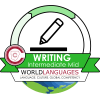 Intermediate Mid
Intermediate Mid
Writers at the Intermediate Mid sublevel are able to meet a number of practical writing needs. They can write short, simple communications, compositions, and requests for information in loosely connected texts about personal preferences, daily routines, common events, and other personal topics. Their writing is framed in present time but may contain references to other time frames. The writing style closely resembles oral discourse. Writers at the Intermediate Mid sublevel show evidence of control of basic sentence structure and verb forms. This writing is best defined as a collection of discrete sentences and/or questions loosely strung together. There is little evidence of deliberate organization. Intermediate Mid writers can be understood readily by natives used to the writing of non-natives. When Intermediate Mid writers attempt Advanced-level writing tasks, the quality and/or quantity of their writing declines and the message may be unclear.
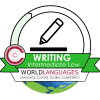 Intermediate Low
Intermediate Low
Writers at the Intermediate Low sublevel are able to meet some limited practical writing needs. They can create statements and formulate questions based on familiar material. Most sentences are recombinations of learned vocabulary and structures. These are short and simple conversational-style sentences with basic word order. They are written almost exclusively in present time. Writing tends to consist of a few simple sentences, often with repetitive structure. Topics are tied to highly predictable content areas and personal information. Vocabulary is adequate to express elementary needs. There may be basic errors in grammar, word choice, punctuation, spelling, and in the formation and use of non-alphabetic symbols. Their writing is understood by natives used to the writing of non-natives, although additional effort may be required. When Intermediate Low writers attempt to perform writing tasks at the Advanced level, their writing will deteriorate significantly and their message may be left incomplete.
For additional information go to
ACTFL PROFICIENCY GUIDELINES 2012
- Details
- Category: Language Proficiency
- Hits: 9721
Writers at the Novice level are characterized by the ability to produce lists and notes, primarily by writing words and phrases. They can provide limited formulaic information on simple forms and documents. These writers can reproduce practiced material to convey the most simple messages. In addition, they can transcribe familiar words or phrases, copy letters of the alphabet or syllables of a syllabary, or reproduce basic characters with some accuracy.
 Novice High
Novice High
Writers at the Novice High sublevel are able to meet limited basic practical writing needs using lists, short messages, postcards, and simple notes. They are able to express themselves within the context in which the language was learned, relying mainly on practiced material. Their writing is focused on common elements of daily life. Novice High writers are able to recombine learned vocabulary and structures to create simple sentences on very familiar topics, but are not able to sustain sentence-level writing all the time. Due to inadequate vocabulary and/or grammar, writing at this level may only partially communicate the intentions of the writer. Novice High writing is often comprehensible to natives used to the writing of non-natives, but gaps in comprehension may occur.
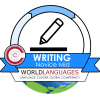 Novice Mid
Novice Mid
Writers at the Novice Mid sublevel can reproduce from memory a modest number of words and phrases in context. They can supply limited information on simple forms and documents, and other basic biographical information, such as names, numbers, and nationality. Novice Mid writers exhibit a high degree of accuracy when writing on well-practiced, familiar topics using limited formulaic language. With less familiar topics, there is a marked decrease in accuracy. Errors in spelling or in the representation of symbols may be frequent. There is little evidence of functional writing skills. At this level, the writing may be difficult to understand even by those accustomed to non-native writers.
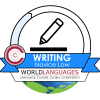 Novice Low
Novice Low
Writers at the Novice Low sublevel are able to copy or transcribe familiar words or phrases, form letters in an alphabetic system, and copy and produce isolated, basic strokes in languages that use syllabaries or characters. Given adequate time and familiar cues, they can reproduce from memory a very limited number of isolated words or familiar phrases, but errors are to be expected.
For additional information go to
ACTFL PROFICIENCY GUIDELINES 2012
- Details
- Category: Language Proficiency
- Hits: 8858
Page 3 of 3















